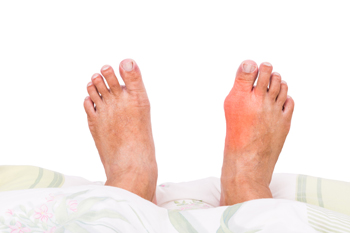Connect With Us
Blogs
Blog
Battling Bony Bunions
Bunions are bony protrusions at the base of the big toe which have developed over time. Repeated pressure on the toe can gradually shift it out of position and tilt towards the other toes. Bunions are also referred to as Hallux abductovalgus, Hallux valgus, HAV, and HV. It is believed that genetics and wearing high heels or narrow-toed footwear can increase the risk of developing this condition. Other conditions that may also contribute to bunions forming include certain types of arthritis, flat feet, and rare genetic bone disorders. Painful bunions can be treated by a podiatrist in a variety of ways from padding and taping, to custom orthotics, night-time splints, icing and other therapies, and by switching to proper footwear. In the most severe cases, a podiatric surgeon can remove the bunion and restore the natural position and beauty of the toe.
If you are suffering from bunion pain, contact Dr. Michael D. Garvin of Florida. Our doctor can provide the care you need to keep you pain-free and on your feet.
What Is a Bunion?
Bunions are painful bony bumps that usually develop on the inside of the foot at the joint of the big toe. As the deformity increases over time, it may become painful to walk and wear shoes. Women are more likely to exacerbate existing bunions since they often wear tight, narrow shoes that shift their toes together. Bunion pain can be relieved by wearing wider shoes with enough room for the toes.
Causes
- Genetics – some people inherit feet that are more prone to bunion development
- Inflammatory Conditions - rheumatoid arthritis and polio may cause bunion development
Symptoms
- Redness and inflammation
- Pain and tenderness
- Callus or corns on the bump
- Restricted motion in the big toe
In order to diagnose your bunion, your podiatrist may ask about your medical history, symptoms, and general health. Your doctor might also order an x-ray to take a closer look at your feet. Nonsurgical treatment options include orthotics, padding, icing, changes in footwear, and medication. If nonsurgical treatments don’t alleviate your bunion pain, surgery may be necessary.
If you have any questions, please feel free to contact our offices located in Port St. Lucie, FL . We offer the newest diagnostic and treatment technologies for all your foot care needs.
Tips for Preventing Blisters
Foot blisters are a common but very annoying problem. Fortunately, there are many ways to prevent them. First, you should look for a shoe that fits well, holds your heel firmly in place, and leaves some wiggle room for your toes. Avoid buying shoes with rough seams or edges along the inside, as these can irritate the skin. Socks are important too. Look for socks that are made with a moisture-wicking material. These will help keep your feet dry. You can also use an antiperspirant or talcum powder. Toughen the skin on your feet by slowly increasing the distance of your walks or runs and by moisturizing your heels if they are dry. If you have certain areas of your feet that are prone to blistering, cover them with sports tape, moleskin, or special patches to protect them. For more information about how to prevent foot blisters, please consult with a podiatrist.
Blisters are prone to making everyday activities extremely uncomfortable. If your feet are hurting, contact Dr. Michael D. Garvin of Florida. Our doctor can provide the care you need to keep you pain-free and on your feet.
Foot Blisters
Foot blisters develop as a result of constantly wearing tight or ill-fitting footwear. This happens due to the constant rubbing from the shoe, which can often lead to pain.
What Are Foot Blisters?
A foot blister is a small fluid-filled pocket that forms on the upper-most layer of the skin. Blisters are filled with clear fluid and can lead to blood drainage or pus if the area becomes infected.
How Do Blisters Form?
Blisters on the feet are often the result of constant friction of skin and material, usually by shoe rubbing. Walking in sandals, boots, or shoes that don’t fit properly for long periods of time can result in a blister. Having consistent foot moisture and humidity can easily lead to blister formation.
Prevention & Treatment
It is important to properly care for the affected area in order to prevent infection and ease the pain. Do not lance the blister and use a Band-Aid to provide pain relief. Also, be sure to keep your feet dry and wear proper fitting shoes. If you see blood or pus in a blister, seek assistance from a podiatrist.
If you have any questions, please feel free to contact our offices located in Port St. Lucie, FL . We offer the newest diagnostic and treatment technologies for all your foot care needs.
Various Reasons Why a Heel Spur May Develop
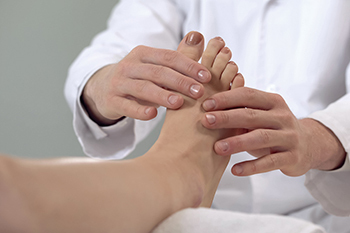
People who develop heel spurs are aware of the pain and discomfort they may cause. It is defined as a bony growth on the back of the heel and between the arch, and is generally felt while walking and running. It is a calcium deposit, and wearing shoes that do not fit correctly may increase the risk of getting a heel spur. They may be one of three shapes, including pointed, shelf-like, and hooked, and may be up to a half inch long. The common symptoms that many patients experience can consist of a chronic ache in the heel of the foot, and there may be inflammation and swelling in the affected area. Additionally, it is often tender to the touch, and it may feel warm. A heel spur happens as a result of strained ligaments and muscles that gradually wear out the soft tissues in the heel. People who have experienced a heel injury, are overweight, or who frequently run and jump on hard surfaces, may be at a greater risk for developing a heel spur. Mild relief can come from resting the affected foot as often possible, and wearing shoes that have adequate support and cushioning. If you have been afflicted by a heel spur, it is suggested that you confer with a podiatrist who can recommend correct treatment options, which may include surgery for permanent removal.
Heel spurs can be incredibly painful and sometimes may make you unable to participate in physical activities. To get medical care for your heel spurs, contact Dr. Michael D. Garvin from Florida. Our doctor will do everything possible to treat your condition.
Heels Spurs
Heel spurs are formed by calcium deposits on the back of the foot where the heel is. This can also be caused by small fragments of bone breaking off one section of the foot, attaching onto the back of the foot. Heel spurs can also be bone growth on the back of the foot and may grow in the direction of the arch of the foot.
Older individuals usually suffer from heel spurs and pain sometimes intensifies with age. One of the main condition's spurs are related to is plantar fasciitis.
Pain
The pain associated with spurs is often because of weight placed on the feet. When someone is walking, their entire weight is concentrated on the feet. Bone spurs then have the tendency to affect other bones and tissues around the foot. As the pain continues, the feet will become tender and sensitive over time.
Treatments
There are many ways to treat heel spurs. If one is suffering from heel spurs in conjunction with pain, there are several methods for healing. Medication, surgery, and herbal care are some options.
If you have any questions feel free to contact our offices located in Port St. Lucie, FL . We offer the latest in diagnostic and treatment technology to meet your needs.
Shared Symptoms of Diabetes Type 1 and Diabetes Type 2
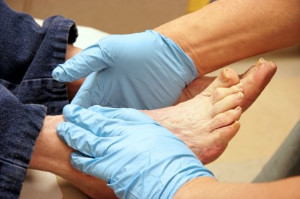
Both Type 1 Diabetes and Type 2 Diabetes can produce long-term complications due to increased levels of glucose (sugar) in the blood. They also share several similar symptoms. For instance, when your body struggles to expel excess amounts of sugar from your blood, you may urinate frequently or get excessively thirsty. Diabetes can also make it difficult for cells to absorb glucose in the blood and convert it into energy, causing you to feel fatigued and weak. A decrease in fluids may cause dry mouth and itchy skin, and disruptions in insulin production or use can affect your ability to get energy from food—making you lose weight unexpectedly or be hungrier than usual. Your feet are often the first area to exhibit signs of diabetes. High glucose levels in the blood can cause nerve damage in the feet, which can result in numbness, burning, tingling, or swelling. This can make it difficult for you to feel when you have a cut or bruise on your feet. Poor circulation associated with diabetes can exacerbate this problem by decreasing the body’s ability to heal any such injury, and wounds may develop. This can be problematic in people with diabetes and may lead to far more serious complications if it is not managed and treated properly. That is why a podiatrist is a critical part of your health team should you be diagnosed with diabetes.
Diabetic foot care is important in preventing foot ailments such as ulcers. If you are suffering from diabetes or have any other concerns about your feet, contact Dr. Michael D. Garvin from Florida. Our doctor can provide the care you need to keep you pain-free and on your feet.
Diabetic Foot Care
Diabetes affects millions of people every year. The condition can damage blood vessels in many parts of the body, especially the feet. Because of this, taking care of your feet is essential if you have diabetes, and having a podiatrist help monitor your foot health is highly recommended.
The Importance of Caring for Your Feet
- Routinely inspect your feet for bruises or sores.
- Wear socks that fit your feet comfortably.
- Wear comfortable shoes that provide adequate support.
Patients with diabetes should have their doctor monitor their blood levels, as blood sugar levels play such a huge role in diabetic care. Monitoring these levels on a regular basis is highly advised.
It is always best to inform your healthcare professional of any concerns you may have regarding your feet, especially for diabetic patients. Early treatment and routine foot examinations are keys to maintaining proper health, especially because severe complications can arise if proper treatment is not applied.
If you have any questions please feel free to contact our offices located in Port St. Lucie, FL . We offer the newest diagnostic and treatment technologies for all your foot and ankle needs.
Can Children Develop Toenail Fungus?
While onychomycosis (toenail fungus) is a common condition, it can be rare among infants and children. This is because children’s nails are smaller and grow faster—making their toenails less hospitable to the fungus. However, when pediatric onychomycosis occurs, it should be dealt with swiftly and properly, as it is not good for a child to have any type of infection. Of course, prevention is always the best option, and something that should be highlighted as most children contract onychomycosis from someone in their own home. Don’t share toenail clippers, soap, towels or other personal grooming items with your child. Encourage them to keep their feet clean and dry, and to always wear clean socks and shoes, as well as flip-flops in public showers, locker rooms and around pools. If your child does develop toenail fungus, understand that what may be appropriate treatment for an adult, may not be safe for a child. If your child’s nails are thickened, brittle, crumbling, or yellowish, bring them to a podiatrist to receive an accurate diagnosis and proper treatment.
The health of a child’s feet is vital to their overall well-being. If you have any questions regarding foot health, contact Dr. Michael D. Garvin of Florida. Our doctor can provide the care you need to keep you pain-free and on your feet.
Tips for Keeping Children's Feet Healthy
- Make sure their shoes fit properly
- Look for any signs of in-toeing or out-toeing
- Check to see if they have Clubfoot (condition that affects your child’s foot and ankle, twisting the heel and toes inward) which is one of the most common nonmajor birth defects.
- Lightly cover your baby’s feet (Tight covers may keep your baby from moving their feet freely, and could prevent normal development)
- Allow your toddler to go shoeless (Shoes can be restricting for a young child’s foot)
- Cut toenails straight across to avoid ingrown toenails
- Keep your child’s foot clean and dry
- Cover cuts and scrapes. Wash any scratches with soap and water and cover them with a bandage until they’ve healed.
If you have any questions, please feel free to contact our offices located in Port St. Lucie, FL . We offer the newest diagnostic and treatment technologies for all your foot care needs.
Different Types of Foot Pain
 Research has indicated the majority of foot pain is generally caused by improper foot function. This can happen from wearing shoes that do not fit correctly, which can affect the plantar fascia, toes, and heels. A common condition that many patients experience is known as plantar fasciitis, and the pain is often felt in the heel area. Morton’s neuroma is characterized by pain in the ball of the foot, and this is caused by damage that is done to the nerve. If a sudden fall occurs, the ankle may become sprained, and relief may be felt when the foot is elevated and wrapped in an elastic bandage. There are many reasons why foot pain can develop, and it is important to consult with a podiatrist who can determine the correct treatment for this type of pain.
Research has indicated the majority of foot pain is generally caused by improper foot function. This can happen from wearing shoes that do not fit correctly, which can affect the plantar fascia, toes, and heels. A common condition that many patients experience is known as plantar fasciitis, and the pain is often felt in the heel area. Morton’s neuroma is characterized by pain in the ball of the foot, and this is caused by damage that is done to the nerve. If a sudden fall occurs, the ankle may become sprained, and relief may be felt when the foot is elevated and wrapped in an elastic bandage. There are many reasons why foot pain can develop, and it is important to consult with a podiatrist who can determine the correct treatment for this type of pain.
Foot Pain
Foot pain can be extremely painful and debilitating. If you have a foot pain, consult with Dr. Michael D. Garvin from Florida. Our doctor will assess your condition and provide you with quality foot and ankle treatment.
Causes
Foot pain is a very broad condition that could be caused by one or more ailments. The most common include:
- Bunions
- Hammertoes
- Plantar Fasciitis
- Bone Spurs
- Corns
- Tarsal Tunnel Syndrome
- Ingrown Toenails
- Arthritis (such as Gout, Rheumatoid, and Osteoarthritis)
- Flat Feet
- Injury (from stress fractures, broken toe, foot, ankle, Achilles tendon ruptures, and sprains)
- And more
Diagnosis
To figure out the cause of foot pain, podiatrists utilize several different methods. This can range from simple visual inspections and sensation tests to X-rays and MRI scans. Prior medical history, family medical history, and any recent physical traumatic events will all be taken into consideration for a proper diagnosis.
Treatment
Treatment depends upon the cause of the foot pain. Whether it is resting, staying off the foot, or having surgery; podiatrists have a number of treatment options available for foot pain.
If you have any questions, please feel free to contact our offices located in Port St. Lucie, FL . We offer the newest diagnostic and treatment technologies for all your foot care needs.
Endoscopic Plantar Fascia Release
Plantar fasciitis is a common injury that occurs when the plantar fascia ligament, which runs along the bottom of the foot, is inflamed. This condition typically causes heel pain, particularly after a period of rest. When caught in its earlier stages, plantar fasciitis can often be remedied with conservative treatment alone. A severe or untreated case of plantar fasciitis, however, can become chronic and may require more extensive treatment. Endoscopic plantar fascia release is a surgical procedure in which the plantar fascia ligament is cut to release tension and reduce inflammation. If you have severe or chronic heel pain, it is strongly suggested that you seek the care of a podiatrist, who can prescribe the proper treatments for you.
Foot surgery is sometimes necessary to treat a foot ailment. To learn more, contact Dr. Michael D. Garvin of Florida. Our doctor will assist you with all of your foot and ankle needs.
When Is Surgery Necessary?
Foot and ankle surgery is generally reserved for cases in which less invasive, conservative procedures have failed to alleviate the problem. Some of the cases in which surgery may be necessary include:
- Removing foot deformities like bunions and bone spurs
- Severe arthritis that has caused bone issues
- Cosmetic reconstruction
What Types of Surgery Are There?
The type of surgery you receive will depend on the nature of the problem you have. Some of the possible surgeries include:
- Bunionectomy for painful bunions
- Surgical fusion for realignment of bones
- Neuropathy decompression surgery to treat nerve damage
Benefits of Surgery
Although surgery is usually a last resort, it can provide more complete pain relief compared to non-surgical methods and may allow you to finally resume full activity.
Surgical techniques have also become increasingly sophisticated. Techniques like endoscopic surgery allow for smaller incisions and faster recovery times.
If you have any questions please feel free to contact our offices located in Port St. Lucie, FL . We offer the newest diagnostic and treatment technologies for all your foot and ankle needs.
Toeing the Line on Toe Pain
The toes are instrumental in everyday movements like walking and running—not to mention athletic activities. Toes are therefore more susceptible to injury, which can result in pain. Toe pain can also be caused by a variety of factors including dysfunction in tissues, bones, nerves, skin, and other parts of the toes. It may also be the result of conditions such as hammertoe, arthritis (including gout), ingrown toenails, bunions, blisters, corns, calluses, tumors, infection, and inflammation (dactylitis). Pain in the toes can be accompanied by feelings of warmth, numbness, as well as other symptoms. If you are experiencing any of these symptoms in your toes, contact a podiatrist who will be able to discover the underlying cause of your toe pain and treat it accordingly.
Foot Pain
Foot pain can be extremely painful and debilitating. If you have a foot pain, consult with Dr. Michael D. Garvin from Florida. Our doctor will assess your condition and provide you with quality foot and ankle treatment.
Causes
Foot pain is a very broad condition that could be caused by one or more ailments. The most common include:
- Bunions
- Hammertoes
- Plantar Fasciitis
- Bone Spurs
- Corns
- Tarsal Tunnel Syndrome
- Ingrown Toenails
- Arthritis (such as Gout, Rheumatoid, and Osteoarthritis)
- Flat Feet
- Injury (from stress fractures, broken toe, foot, ankle, Achilles tendon ruptures, and sprains)
- And more
Diagnosis
To figure out the cause of foot pain, podiatrists utilize several different methods. This can range from simple visual inspections and sensation tests to X-rays and MRI scans. Prior medical history, family medical history, and any recent physical traumatic events will all be taken into consideration for a proper diagnosis.
Treatment
Treatment depends upon the cause of the foot pain. Whether it is resting, staying off the foot, or having surgery; podiatrists have a number of treatment options available for foot pain.
If you have any questions, please feel free to contact our offices located in Port St. Lucie, FL . We offer the newest diagnostic and treatment technologies for all your foot care needs.
Understanding Navicular Stress Fractures
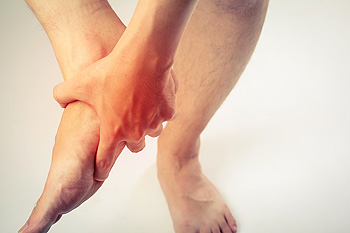
The navicular bone is one of the 26 bones in the foot and is located across the inside top of the foot just in front of the ankle joint. The navicular connects the ankle to the foot bones and helps to form the arch that enables you to walk. Navicular stress fractures, which are hairline cracks in the bone, are often sustained by athletes who kick, twist or sprint. The result is often a chronic midfoot ache, but the vague location of the pain may make it difficult to diagnose. Hopping or standing on tiptoe can be one way of recognizing a navicular stress fracture. Someone with extremely high arches or a longer second toe may be more likely to sustain this injury, experts believe. X-rays may not be able to recognize navicular stress fractures, but an MRI or other imaging test can be more successful. Treatment may involve staying off the foot and wearing a cast for up to six weeks, or longer. If midfoot pain is becoming a nuisance, please consult with a podiatrist for a complete exam, diagnosis and options for treatment.
Stress fractures occur when there is a tiny crack within a bone. To learn more, contact Dr. Michael D. Garvin from Florida. Our doctor can provide the care you need to keep you pain free and on your feet.
How Are They Caused?
Stress fractures are the result of repetitive force being placed on the bone. Since the lower leg and feet often carry most of the body’s weight, stress fractures are likely to occur in these areas. If you rush into a new exercise, you are more likely to develop a stress fracture since you are starting too much, too soon. Pain resulting from stress fractures may go unnoticed at first, however it may start to worsen over time.
Risk Factors
- Gender – They are more commonly found in women compared to men.
- Foot Problems – People with unusual arches in their feet are more likely to develop stress fractures.
- Certain Sports – Dancers, gymnasts, tennis players, runners, and basketball players are more likely to develop stress fractures.
- Lack of Nutrients – A lack of vitamin D and calcium may weaken the bones and make you more prone to stress fractures
- Weak Bones – Osteoporosis can weaken the bones therefore resulting in stress fractures
Stress fractures do not always heal properly, so it is important that you seek help from a podiatrist if you suspect you may have one. Ignoring your stress fracture may cause it to worsen, and you may develop chronic pain as well as additional fractures.
If you have any questions, please feel free to contact our offices located in Port St. Lucie, FL . We offer the newest diagnostic and treatment technologies for all your foot care needs.
More...
Preventing Poor Blood Circulation
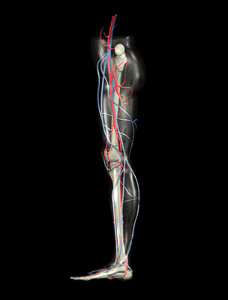 If your feet feel cold, especially during these winter months, it is because it is your body’s natural response for conserving heat when it is too cold. Your body “tries to maintain its internal temperature by constricting small blood vessels under the surface of the skin. This allows more blood to move deeper in the body, so your core stays warm.” However, this causes your body’s extremities, like the feet, to receive poor blood circulation. When taking care of your cold feet, try to wear warm, breathable socks that help wick away moisture. Opt for wool in place of cotton. Other methods include warming your feet up in warm water, drinking hot liquids, moving around to get your blood circulation going, and investing in shoe inserts to help insulate the insides of your shoes.
If your feet feel cold, especially during these winter months, it is because it is your body’s natural response for conserving heat when it is too cold. Your body “tries to maintain its internal temperature by constricting small blood vessels under the surface of the skin. This allows more blood to move deeper in the body, so your core stays warm.” However, this causes your body’s extremities, like the feet, to receive poor blood circulation. When taking care of your cold feet, try to wear warm, breathable socks that help wick away moisture. Opt for wool in place of cotton. Other methods include warming your feet up in warm water, drinking hot liquids, moving around to get your blood circulation going, and investing in shoe inserts to help insulate the insides of your shoes.
Poor circulation is a serious condition and needs immediate medical attention. If you have any concerns with poor circulation in your feet contact Dr. Michael D. Garvin of Florida. Our doctor will treat your foot and ankle needs.
Poor Circulation in the Feet
Poor blood circulation in the feet and legs is can be caused by peripheral artery disease (PAD), which is the result of a buildup of plaque in the arteries.
Plaque buildup or atherosclerosis results from excess calcium and cholesterol in the bloodstream. This can restrict the amount of blood which can flow through the arteries. Poor blood circulation in the feet and legs are sometimes caused by inflammation in the blood vessels, known as vasculitis.
Causes
Lack of oxygen and oxygen from poor blood circulation restricts muscle growth and development. It can also cause:
- Muscle pain, stiffness, or weakness
- Numbness or cramping in the legs
- Skin discoloration
- Slower nail & hair growth
- Erectile dysfunction
Those who have diabetes or smoke are at greatest risk for poor circulation, as are those who are over 50. If you have poor circulation in the feet and legs it may be caused by PAD and is important to make changes to your lifestyle in order to reduce risk of getting a heart attack or stroke. Exercise and maintaining a healthy lifestyle will dramatically improve conditions.
As always, see a podiatrist as he or she will assist in finding a regimen that suits you. A podiatrist can also prescribe you any needed medication.
If you have any questions please feel free to contact our offices located in Port St. Lucie, FL . We offer the newest diagnostic and treatment technologies for all your foot and ankle needs.
Treatments for Ingrown Toenails
 Ingrown toenails can be very painful to experience. Most common in teenagers, though fairly common in the greater population, an ingrown toenail is characterized by the toenail digging into and breaking the adjacent soft tissue. This can lead to infection if the breaks in the skin remain for too long. Treatment of ingrown toenails range from clipping the nail more appropriately to surgically removing the nail or even destroying the growth plate in the nail bed. For chronic sufferers these surgical options may be necessary. It is best to consult a podiatrist if you have ingrown toenails.
Ingrown toenails can be very painful to experience. Most common in teenagers, though fairly common in the greater population, an ingrown toenail is characterized by the toenail digging into and breaking the adjacent soft tissue. This can lead to infection if the breaks in the skin remain for too long. Treatment of ingrown toenails range from clipping the nail more appropriately to surgically removing the nail or even destroying the growth plate in the nail bed. For chronic sufferers these surgical options may be necessary. It is best to consult a podiatrist if you have ingrown toenails.
Ingrown toenails can become painful if they are not treated properly. For more information about ingrown toenails, contact Dr. Michael D. Garvin of Florida. Our doctor can provide the care you need to keep you pain-free and on your feet.
Ingrown Toenails
Ingrown toenails occur when a toenail grows sideways into the bed of the nail, causing pain, swelling, and possibly infection.
Causes
- Bacterial infections
- Improper nail cutting such as cutting it too short or not straight across
- Trauma to the toe, such as stubbing, which causes the nail to grow back irregularly
- Ill-fitting shoes that bunch the toes too close together
- Genetic predisposition
Prevention
Because ingrown toenails are not something found outside of shoe-wearing cultures, going barefoot as often as possible will decrease the likeliness of developing ingrown toenails. Wearing proper fitting shoes and using proper cutting techniques will also help decrease your risk of developing ingrown toenails.
Treatment
Ingrown toenails are a very treatable foot condition. In minor cases, soaking the affected area in salt or antibacterial soaps will not only help with the ingrown nail itself, but also help prevent any infections from occurring. In more severe cases, surgery is an option. In either case, speaking to your podiatrist about this condition will help you get a better understanding of specific treatment options that are right for you.
If you have any questions please feel free to contact our offices located in Port St. Lucie, FL . We offer the newest diagnostic and treatment technologies for all your foot and ankle needs.
Sever’s disease a cause of childhood ankle pain
 Ankle pain is a condition that can affect anyone at any age. Depending on the severity of the condition, this pain can be very debilitating, limiting mobility and the ability to perform in sports or certain activities in one’s daily life. In growing children, ankle pain can manifest in the form of Sever’s disease. Sever’s disease is a condition in which the ankle’s calcaneus bone is not fully fused together, creating pain should the Achilles tendon pull on the area where it attaches. The condition typically develops in children who are very active. Along with pain, other symptoms include swelling and tenderness.
Ankle pain is a condition that can affect anyone at any age. Depending on the severity of the condition, this pain can be very debilitating, limiting mobility and the ability to perform in sports or certain activities in one’s daily life. In growing children, ankle pain can manifest in the form of Sever’s disease. Sever’s disease is a condition in which the ankle’s calcaneus bone is not fully fused together, creating pain should the Achilles tendon pull on the area where it attaches. The condition typically develops in children who are very active. Along with pain, other symptoms include swelling and tenderness.
Sever's disease often occurs in children and teens. If your child is experiencing foot or ankle pain, see Dr. Michael D. Garvin from Florida. Our doctor can treat your child’s foot and ankle needs.
Sever’s Disease
Sever’s disease is also known as calcaneal apophysitis, which is a medical condition that causes heel pain I none or both feet. The disease is known to affect children between the ages of 8 and 14.
Sever’s disease occurs when part of the child’s heel known as the growth plate (calcaneal epiphysis) is attached to the Achilles tendon. This area can suffer injury when the muscles and tendons of the growing foot do not keep pace with bone growth. Therefore, the constant pain which one experiences at the back of the heel will make the child unable to put any weight on the heel. The child is then forced to walk on their toes.
Symptoms
Acute pain – Pain associated with Sever’s disease is usually felt in the heel when the child engages in physical activity such as walking, jumping and or running.
Highly active – Children who are very active are among the most susceptible in experiencing Sever’s disease, because of the stress and tension placed on their feet.
If you have any questions, please feel free to contact our offices located in Port St. Lucie, FL . We offer the newest diagnostic and treatment technologies for all your foot and ankle injuries.
Managing Blisters
 Those who spend a large amount of time putting pressure on their feet are prone to developing blisters, or pockets of fluid between layers of skin which develop due to friction. Minor blisters should not be popped, and instead left alone and covered to provide cushioning and avoid further friction. Prevent the development of blisters by wearing proper-fitting shoes and socks that provide ample comfort and support. Be sure to treat blisters immediately after discovery to avoid pain and disruption of daily activities. If a blister ruptures, immediately disinfect the area and treat it with antibiotic ointment. Consult with a doctor if the pain persists or there is any sign of infection.
Those who spend a large amount of time putting pressure on their feet are prone to developing blisters, or pockets of fluid between layers of skin which develop due to friction. Minor blisters should not be popped, and instead left alone and covered to provide cushioning and avoid further friction. Prevent the development of blisters by wearing proper-fitting shoes and socks that provide ample comfort and support. Be sure to treat blisters immediately after discovery to avoid pain and disruption of daily activities. If a blister ruptures, immediately disinfect the area and treat it with antibiotic ointment. Consult with a doctor if the pain persists or there is any sign of infection.
Blisters are prone to making everyday activities extremely uncomfortable. If your feet are hurting, contact Dr. Michael D. Garvin of Florida. Our doctor can provide the care you need to keep you pain-free and on your feet.
Foot Blisters
Foot blisters develop as a result of constantly wearing tight or ill-fitting footwear. This happens due to the constant rubbing from the shoe, which can often lead to pain.
What Are Foot Blisters?
A foot blister is a small fluid-filled pocket that forms on the upper-most layer of the skin. Blisters are filled with clear fluid and can lead to blood drainage or pus if the area becomes infected.
How Do Blisters Form?
Blisters on the feet are often the result of constant friction of skin and material, usually by shoe rubbing. Walking in sandals, boots, or shoes that don’t fit properly for long periods of time can result in a blister. Having consistent foot moisture and humidity can easily lead to blister formation.
Prevention & Treatment
It is important to properly care for the affected area in order to prevent infection and ease the pain. Do not lance the blister and use a Band-Aid to provide pain relief. Also, be sure to keep your feet dry and wear proper fitting shoes. If you see blood or pus in a blister, seek assistance from a podiatrist.
If you have any questions, please feel free to contact our offices located in Port St. Lucie, FL . We offer the newest diagnostic and treatment technologies for all your foot care needs.
